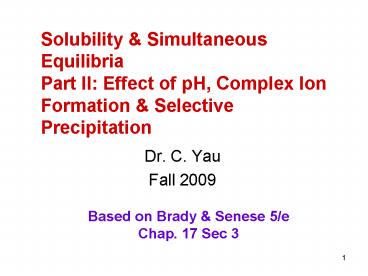Solubility - PowerPoint PPT Presentation
1 / 13
Title: Solubility
1
Solubility Simultaneous EquilibriaPart II
Effect of pH, Complex Ion Formation Selective
Precipitation
- Dr. C. Yau
- Fall 2009
Based on Brady Senese 5/eChap. 17 Sec 3
1
2
Effect of pH on Solubility
Consider the following equilibrium CaCO3 (s)
Ca2 (aq) CO32- (aq)
Why would the pH affect the solubility? Could
addition of H3O affect the solubility? Would you
expect it to affect Ca2 or CO32-? CO32- (aq)
H3O (aq) HCO3- (aq) H2O (l) HCO3-
(aq) H3O (aq) H2CO3 (aq) H2O (l)
If the cmpd contains the anion of a weak acid,
addition of H3O (from a strong acid) increases
it solubility.
2
3
- Addition of acid to mineral sample is a field
test to identify presence of carbonates. - What would one look for as a positive test for
carbonates? - CO32- (aq) H3O (aq) HCO3- (aq)
H2O (l) - HCO3- (aq) H3O (aq) H2CO3 (aq)
H2O (l)
If the addition of acid to a mineral sample
produces effervescence, the sample contains
carbonates.
4
Effect of Adding Strong Acid
- Write balanced eqns to explain whether addition
of a strong acid would affect the solubility of
the following compounds - a) lead(II) bromide
- b) copper(II) hydroxide
- c) iron(II) sulfide
- Write equations to explain the effect.
5
Selective Precipitation
- Consider the Ksp of AgCl and Ag2CrO4
- Ksp Solubility
- AgCl 1.8x10-10 1.3x10-5 M
- Ag2CrO4 2.6x10-12 8.7x10-5 M
- If we add Ag to a soln containing
- 0.10 M Cl- and 0.10 M CrO42-, what will happen?
- Ans. Ag2CrO4 is more soluble. AgCl will
precipitate out first, leaving CrO42- in solution.
6
- CrO42- and Cl- can be separated by adding Ag.
- Ag will precipitate out the Cl- as AgCl (s).
- The mixture is centrifuged to spin down the white
AgCl ppt. - The supernatant soln containing the CrO42- is
then pipetted out.
7
Complex Ion Formation
- Metal ions can combine with anions or neutral
molecules to form complex ions - Cu2 4 H2O Cu(H2O)42
- Fe2 6 CN? Fe(CN)64?
- The H2O and CN? in the above reactions are called
ligands. They are acting as Lewis bases. The
metal cations are acting as Lewis acids.
8
Aqueous Metal Ions Are Complex Ions
- Water acts as a ligand, the Lewis base that forms
a coordinate covalent bond with the metal. - In the solvation of ionic compounds, ions are
dissolved in water through ion-dipole
interactions - Complex ions are soluble, hence complexation is a
means of dissolving some solids.
9
Writing Complex Ion Formation Eqns
- Write the equation for the complex ion formation
of the aluminum ion with 4 hydroxide as ligands. - Al3 (aq) 4 OH- (aq)
- Write the equation for the complex ion formation
of the tin(IV) ion with 6 fluoride ions as
ligands. - Write the equation for the complex ion formation
of the mercury(II) ion with 4 chloride ions as
ligands. - Practice p.720 17.62
10
Complexation Kinst
- Complexes are governed by the instability
constant, Kinst - Ag(NH3)2 Ag
2NH3 - When we reverse an equation, we invert K, thus
Kform1/Kinst. - Ag 2NH3 Ag(NH3)2
11
Complex Ion Formation Increases Solubility of a
Salt
- Consider the dissolution of AgBr(s) and what
happens when NH3 is added - AgBr (s) Ag (aq) Br- (aq)
- Ag(NH3)2
AgBr becomes more soluble.
12
Classical Schemefor Identifying "Group I Cations"
- Ksp Solubility
- Hg2Cl2 1.2x10-18 M 6.7x10-7
- AgCl 1.8x10-10 M 1.3x10-5
- PbCl2 1.7x10-5 M 1.6x10-2
- Given a soln possibly containing some combination
of Hg22, Ag and Pb2 ions, you are to determine
which one or ones are present.
13
SolubilityHg2Cl2 6.7x10-7 MAgCl 1.3x10-5 M
PbCl2 1.6x10-2 M (soluble when hot)
Write a flowchart for this analysis.
- To unknown soln, add excess amt of 6MHCl.
- If a ppt forms, one or more of the cations are
present. - Heat the mixture to boiling and remove the
supernatant. To the supernatant, add K2CrO4. If a
yellow ppt forms, Pb2 is present. - To the ppt, add 6 M NH3. If a ppt remains, Hg22
is present. - To the supernatant, neutralize the NH3 with HCl.
If a white ppt forms, Ag is present.































